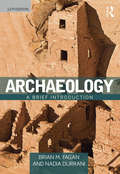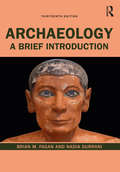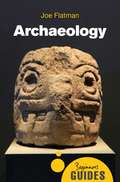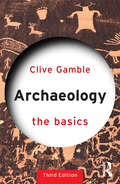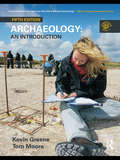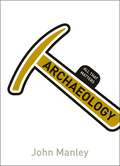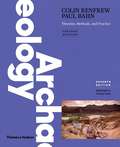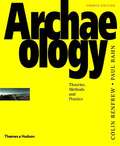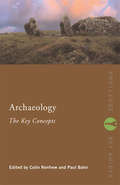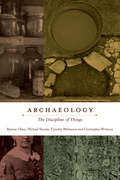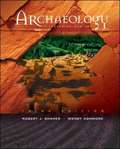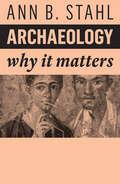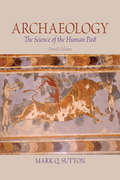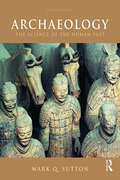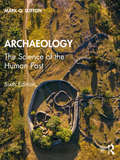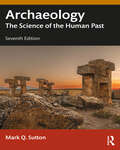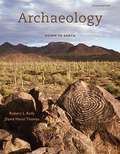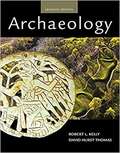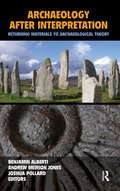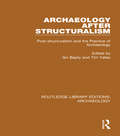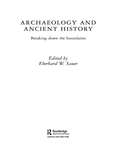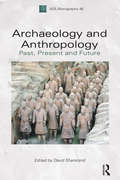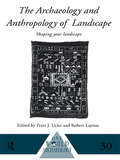- Table View
- List View
Archaeology: A Brief Introduction
by Brian M. Fagan Nadia DurraniArchaeology is a jargon-free and accessible introduction to the field which details how archaeologists study the human past in all its fascinating diversity. Now in its twelfth edition, this classic textbook has been updated to reflect the latest research and new findings in the field. Reflecting the global scope of the discipline, the book has a truly international coverage of important discoveries and sites from many corners of the globe. Individual chapters examine archaeology and its history, considering the role of the archaeologist and how they discover, investigate and classify sites and artifacts. This journey through archaeology also includes a discussion of important individuals and groups, and some of the ways in which archaeologists attempt to explain major social and cultural changes in the remote past. Archaeology ends with an outline of the complex world of cultural resource management and gives invaluable advice on how to become an archaeologist. Richly illustrated throughout, this popular and engaging textbook on archaeological methods has introduced generations of students to the captivating world of archaeology.
Archaeology: A Brief Introduction
by Brian M. Fagan Nadia DurraniArchaeology is a jargon-free and accessible introduction to the field which details how archaeologists study the human past in all its fascinating diversity. Now in its thirteenth edition, this classic textbook has been updated to include the latest research and new findings in the field. Reflecting the global scope of the discipline, the book has a truly international coverage of important discoveries and sites from many corners of the globe. Individual chapters examine archaeology and its history, considering the role of the archaeologist and how they discover, investigate and classify sites and artifacts. This journey through archaeology also includes a discussion of important individuals and groups, and some of the ways in which archaeologists attempt to explain major social and cultural changes in the remote past. Archaeology ends with an outline of the complex world of cultural resource management and gives invaluable advice on how to become an archaeologist. Richly illustrated throughout, this popular and engaging textbook on archaeological methods has introduced generations of students to the captivating world of archaeology.
Archaeology: A Beginner's Guide (Beginner's Guides)
by Joe FlatmanArchaeology is more popular than ever. TV and film have made it seem accessible and exciting, and the number of budding amateurs is on the rise, as is government support for archaeological initiatives on a global scale. From coins and combs to battlefields and plantations, archaeologist Joe Flatman provides an incisive introduction to the practice of archaeology. Through comparative case studies he demonstrates how the archaeological mindset reveals unexpected truths about the most modern phenomena. Suddenly a landfill site can expose more about our drinking habits than we may like to admit, and airports become sites as intriguing and complex as the towns and villages they were built over. Flatman also trains his eye on the future and reveals how archaeology can help us predict - and even prevent - the crises that are facing us today.
Archaeology: Trajectories To Early States (The Basics)
by Clive GambleNow in an updated third edition, Archaeology: The Basics provides a straightforward and engaging introduction to the world of Archaeology. This book answers key questions about how and why we practice archaeology and examines the theories and themes underpinning the subject. Fully updated, this new edition includes a wide range of examples and new material on key growth areas including:* Evolutionary approaches in current archaeology* The archaeology of landscape and place* The impact and value of archaeology* Conflict archaeology and the politics of the pastWith 12 new illustrations, four new boxes and additional case studies this text is essential reading for all those beginning to study archaeology and anyone who has ever questioned the past.
Archaeology: An Introduction
by Kevin Greene Tom MooreArchaeology: An Introduction looks behind the popular aspects of archaeology such as the discovery and excavation of sites, the study of human remains and animal bones, radiocarbon dating, museums and 'heritage' displays, and reveals the methods used by archaeologists. It also explains how the subject emerged from an amateur pursuit in the eighteenth century into a serious discipline, and explores changing fashions in interpretation in recent decades. This fifth edition has been updated by a new co-author, Tom Moore, and continues to include key references and guidance to help new readers find their way through the ever expanding range of archaeological publications. It conveys the excitement of new archaeological discoveries that appear on television or in newspapers while helping readers to evaluate them by explaining the methods and theories that lie behind them. Above all, while serving as a lucid textbook, it remains a very accessible account that will interest a wide readership. In addition to drawing upon examples and case studies from many regions of the world and periods of the past, it incorporates the authors' own fieldwork, research and teaching and features a new four-colour text design and colour illustrations plus an additional 50 topic boxes. The comprehensive glossary and bibliography are complemented by a support website hosted by Routledge to assist further study and wider learning. It includes chapter overviews, a testbank of questions, powerpoint discussion questions, web-links to support material for every chapter plus an online glossary and image bank. New to the fifth edition: inclusion of the latest survey techniques updated material on the development in dating, DNA analysis, isotopes and population movement coverage of new themes such as identity and personhood how different societies are defined from an anthropological point of view and the implications of this for archaeological interpretation the impact of climate change and sustainability on heritage management more on the history of archaeology Visit the companion website at www.routledge.com/textbooks/greene for additional resources, including: chapter overviews a testbank of questions PowerPoint discussion questions links to support material for every chapter an online glossary and image bank
Archaeology: All That Matters
by John Manley- When did archaeology begin? - Who were the first antiquarians in early modern Europe? - How did archaeology free human history from biblical creationism? - How did archaeology become a pseudo-scientific discipline? - Who built the first museum? Leading expert Dr John Manley starts by dealing with the processes and techniques used by archaeologists, in the past and today. He then uses the results of famous archaeological studies both to illustrate the power of archaeology, and to show specifically what archaeology has taught us about Roman, Egyptian, ancient, and surprisingly recent, history. In an exciting final chapter, Manley wonders how archaeology may adapt over time, exploring how the archaeologists of the future may examine our own era. Ideal for students or for general reading, this book delivers a thorough and comprehensive introduction to archaeology. All That Matters about archaeology. All That Matters books are a fast way to get right to the heart of key issues.
Archaeology: Theories, Methods, and Practice (Seventh Edition)
by Colin Renfrew Paul BahnSince its first edition, Renfrew and Bahn's Archaeology: Theories, Methods, and Practice has been the leading academic source on what archaeologists do and how they do it. This indispensable book is a comprehensive introduction to archaeology in the field, the laboratory, and the library. Archaeology is organized around the key questions that archaeologists ask about the past and details the practical and theoretical ways in which answers to those questions are sought. The seventh edition has been thoroughly revised and updated to include the newest developments in the subject and the latest discoveries, and is newly designed with additional box features and extensive drawings, charts, and photographs, all in full color.
Archaeology: Theories, Methods, and Practice (4th Edition)
by Colin Renfrew Paul BahnA textbook on archaeology: its history; the variety of evidence; survey and excavation of sites and features; dating methods; social, environmental and cognitive archaeology; 5 case studies, and the archaeology of people.
Archaeology: Theories, Methods, And Practice (Routledge Key Guides)
by Colin Renfrew Paul BahnFrom two of the best-known archaeological writers in the trade, this outstanding resource provides a thorough survey of the key ideas in archaeology, and how they impact on archaeological thinking and method. Clearly written, and easy to follow, Archaeology: The Key Concepts collates entries written specifically by field specialists, and each entry offers a definition of the term, its origins and development, and all the major figures involved in the area. The entries include: thinking about landscape archaeology of cult and religion cultural evolution concepts of time urban societies the antiquity of humankind archaeology of gender feminist archaeology experimental archaeology multiregional evolution. With guides to further reading, extensive cross-referencing, and accessibly written for even beginner students, this book is a superb guide for anyone studying, teaching, or with any interest in this fascinating subject.
Archaeology: The Discipline of Things
by Michael Shanks Christopher Witmore Timothy Webmoor Bjørnar OlsenArchaeology has always been marked by its particular care, obligation, and loyalty to things. While archaeologists may not share similar perspectives or practices, they find common ground in their concern for objects monumental and mundane. This book considers the myriad ways that archaeologists engage with things in order to craft stories, both big and small, concerning our relations with materials and the nature of the past. Literally the "science of old things," archaeology does not discover the past as it was but must work with what remains. Such work involves the tangible mediation of past and present, of people and their cultural fabric, for things cannot be separated from society. Things are us. This book does not set forth a sweeping new theory. It does not seek to transform the discipline of archaeology. Rather, it aims to understand precisely what archaeologists do and to urge practitioners toward a renewed focus on and care for things.
Archaeology: Discovering Our Past, Third Edition
by Robert J. Sharer Wendy AshmoreThis is the only textbook which is organized to follow the steps of the actual process of archaeological research in order to present the methods and theoretical frameworks of archaeology, from the planning and actual conduct of field research, to the different ways archaeological data is interpreted to produce an understanding of the past. It is also the only such textbook to give the reader a series of firsthand accounts of what its like to do archaeology, written by a variety of practicing archaeologists.
Archaeology: Why It Matters (Why It Matters #1)
by Ann B. StahlHistory lies beneath our feet and in the landscapes around us. In contrast to the history that comes from studying texts, archaeology is the study of history through objects, monuments, and other traces of past lives: history that extends beyond the earliest writings into the deep past, revealing the varied pathways that led to the present, and the challenges – often similar to those we face today – that confronted our ancestors. Ann Stahl argues that archaeology is unique in its focus on the everyday lives of all peoples in all places and times. From ancient temples to humble homes, archaeologists piece together worlds that would otherwise be lost: knowledge that shows us how routine actions have shaped societies, how and why societies have changed in light of environment, politics, and culture – and perhaps what the future holds for our societies too. Using compelling examples from a storied international career, Stahl provides the perfect summary of why archaeology is both a vitally important and enjoyable subject to study.
Archaeology: The Science of the Human Past
by Mark Q SuttonIlluminating the world of archaeology. Archaeology conveys the excitement of archaeological discovery and explains how archaeologists think as they scientifically find, analyze, and interpret evidence. The main objective of this text is to provide an introduction to the broad and fascinating world of archaeology from the scientific perspective. Discussions on the theoretical aspects of archaeology, as well as the practical applications of what is learned about the past, have been updated and expanded upon in this fourth edition. Learning GoalsUpon completing this book, readers will be able to: Discuss the theoretical aspects of archaeology. Apply what has been learned about the past. Identify the various perspectives archaeologists have.
Archaeology: The Science of the Human Past
by Mark Q SuttonArchaeology: The Science of the Human Past provides an introduction to the broad and fascinating world of archaeology from the scientific perspective. Conveying the exhilaration of archaeological work, it explores the ways archaeologists analyse and interpret evidence. Varying perspectives are considered to provide holistic coverage of archaeological techniques and methods and show how the complexity of the past can be captured by the empirical science of archaeology. The Fifth Edition has been updated and revised to include the latest archaeological approaches and the impact developments in archaeological science have made in recent years. The chapter on bioarchaeology has been completely rewritten to reflect these developments. Archaeology: An Introduction will allow students to understand the theoretical and scientific aspects of archaeology and how various archaeological perspectives and techniques help us understand how and what we know about the past.
Archaeology: The Science of the Human Past
by Mark Q. SuttonArchaeology: The Science of the Human Past provides students with a thorough understanding of what archaeology is and how it operates and familiarizes them with fundamental archaeological concepts and methods. This volume introduces the basic components of archaeology, including sites, artifacts, ecofacts, remote sensing, and excavation. It discusses how archaeologists obtain and classify information and how they analyze this information to formulate and test models of what happened in the past. Cultural resource management and the laws and regulations that deal with archaeology around the world are described. Archaeology is placed in the context of contemporary issues, from environmental problems to issues affecting Indigenous populations. The sixth edition has been updated and simplified to create a more streamlined volume to meet the needs of the students and teachers for whom it is designed, reflecting the latest developments in archaeological techniques and approaches. Allowing students to understand the theoretical and scientific aspects of archaeology and how various archaeological perspectives and techniques help us understand how and what we know about the past, Archaeology: The Science of the Human Past is an ideal introduction to archaeology.
Archaeology: The Science of the Human Past
by Mark Q. SuttonArchaeology: The Science of the Human Past introduces students to the wide-ranging and fascinating world of archaeology and provides them with a comprehensive understanding of fundamental archaeological concepts and methods.The seventh edition keeps pace with the developments in archaeological science with up-to-date information on dating, artifact analyses, and remote sensing. Theoretical developments in power, gender, and cognition are also included. Introducing the key components of archaeology, including sites, artifacts, ecofacts, remote sensing, and excavation, it discusses the ways archaeologists obtain, analyze, and interpret evidence. Varying perspectives are considered to provide holistic coverage of how archaeological techniques and methods are used to formulate and test models of what happened in the past. Cultural resource management and the laws and regulations that deal with archaeology around the world are described. Archaeology is placed in the context of current topics, from environmental problems to issues affecting Indigenous populations.Archaeology: The Science of the Human Past remains an ideal introduction to archaeology by offering students a broad and clear understanding of the theoretical and scientific aspects of archaeology and how various archaeological perspectives and techniques help us comprehend not just the past but the contemporary world as well.
Archaeology: Down to Earth (4th edition)
by David Hurst Thomas Robert L. KellyThis new brief edition pairs two of archaeology's most recognized names--David Hurst Thomas of the American Museum of Natural History and Robert L. Kelly of the University of Wyoming. The authors' passionate, down-to-earth introduction to archaeological method and theory makes the book ideal for all students, whether or not they intend to pursue a career in archaeology. Students will gain an immediate, concrete impression of what the practice of archaeology involves. The authors include well-chosen examples to show how archaeologists have worked through actual problems in the field and in the lab. After using this text, students will be better able to ask questions, solve problems, and discern "truth" from "fiction. " They will learn about the nature of archaeological data and how archaeologists do such things as archaeological survey and excavation. They will also develop their sense of scientific logic and gain a better understanding of career opportunities available to archaeologists. This edition is enhanced with a new full-color design that improves the visual presentation and enables students to more clearly see the key points of an image. A rich array of supplemental resources includes a new companion website as well as the option to use the DOING FIELDWORK: ARCHAEOLOGICAL DEMONSTRATIONS CD-ROM, Version 2. 0, also developed by the authors.
Archaeology
by David Thomas Robert KellyThe seventh edition of ARCHAEOLOGY reflects the most recent research and changes in the field, while making core concepts easy to understand through an engaging writing style, personalized examples, and high-interest topics. This text pairs two of archaeology's most recognized names, Robert L. Kelly and David Hurst Thomas, who together have over 75 years of experience leading excavations.
Archaeology After Interpretation: Returning Materials to Archaeological Theory
by Benjamin Alberti Andrew Meirion Jones Joshua PollardA new generation of archaeologists has thrown down a challenge to post-processual theory, arguing that characterizing material symbols as arbitrary overlooks the material character and significance of artifacts. This volume showcases the significant departure from previous symbolic approaches that is underway in the discipline. It brings together key scholars advancing a variety of cutting edge approaches, each emphasizing an understanding of artifacts and materials not in terms of symbols but relationally, as a set of associations that compose people’s understanding of the world. Authors draw on a diversity of intellectual sources and case studies, paving a dynamic road ahead for archaeology as a discipline and theoretical approaches to material culture.
Archaeology After Structuralism: Post-structuralism and the Practice of Archaeology (Routledge Library Editions: Archaeology)
by Ian Bapty Tim YatesMost practising archaeologists have preferred to leave the deep theories of what lies behind their methods and perceptions on one side. Now archaeologists have faced up to the difficult task of making (or not making) the connections between the past, interpretation and the present. The writers of this volumes address the problems of archaeology, sometimes warily and sometimes with enthusiasm. The connections are not easy to accomplish: a great deal of theory seems of little relevance to the everyday practice of archaeology, and much of post-structuralism refers exclusively back to itself rather than to the more specific concerns of a historical discipline. But where the junction between post-structuralism and archaeology can be made, the results are innovative and enriching. Originally published in 1990.
Archaeology: All That Matters (All That Matters)
by John Manley- When did archaeology begin?- Who were the first antiquarians in early modern Europe?- How did archaeology free human history from biblical creationism?- How did archaeology become a pseudo-scientific discipline?- Who built the first museum? Leading expert Dr John Manley starts by dealing with the processes and techniques used by archaeologists, in the past and today. He then uses the results of famous archaeological studies both to illustrate the power of archaeology, and to show specifically what archaeology has taught us about Roman, Egyptian, ancient, and surprisingly recent, history. In an exciting final chapter, Manley wonders how archaeology may adapt over time, exploring how the archaeologists of the future may examine our own era.Ideal for students or for general reading, this book delivers a thorough and comprehensive introduction to archaeology. All That Matters about archaeology. All That Matters books are a fast way to get right to the heart of key issues.
Archaeology and Ancient History: Breaking Down the Boundaries
by Eberhard W. SauerChallenging both traditional and fashionable theories, this collection of pieces from an international range of contributors explores the separation of the human past into history, archaeology and their related sub-disciplines. Each case study challenges the validity of this separation and asks how we can move to a more holistic approach in the study of the relationship between history and archaeology. While the focus is on the ancient world, particularly Greece and Rome, rhe lessons learnded in this book make it an essential addition to all studies of history and archaeology.
Archaeology and Anthropology: Past, Present and Future (Association Of Social Anthropologists Monographs #48)
by David ShanklandThough archaeologists have long acknowledged the work of social anthropologists, anthropologists have been much less eager to repay the compliment. This volume argues that the time has come to recognise the insights archaeological approaches can bring to anthropology. Archaeology's rigorous approach to evidence and material culture; its ability to develop flexible research methodologies; its readiness to work with large-scale models of comparative social change, and to embrace the latest technology all means that it can offer valuable methods that can enrich and enhance current anthropological thinking.Cross-disciplinary and international in scope, this exciting volume draws together cutting-edge essays on the relationship between the two disciplines, arguing for greater collaboration and pointing to new concepts and approaches for anthropology. With contributions from leading scholars, this book will be essential reading for students and scholars of archaeology, anthropology and related disciplines.
The Archaeology and Anthropology of Landscape: Shaping Your Landscape (One World Archaeology #Vol. 30)
by Peter J. Ucko Robert LaytonThe Archaeology and Anthropology of Landscape contributes to the development of theory in archaeology and anthropology, provides new and varied case studies of landscape and environment from five continents, and raises important policy issues concerning development and the management of heritage.
